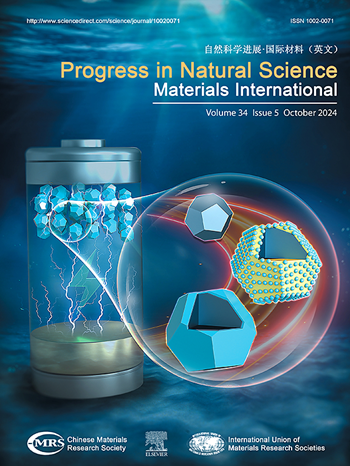Simultaneous measurement of thermal conductivity, heat capacity, and interfacial thermal conductance by leveraging negative delay-time data in time-domain thermoreflectance
IF 7.1
2区 材料科学
Q2 MATERIALS SCIENCE, MULTIDISCIPLINARY
Progress in Natural Science: Materials International
Pub Date : 2025-04-01
DOI:10.1016/j.pnsc.2025.02.001
引用次数: 0
Abstract
Time-domain thermoreflectance (TDTR) is a widely used technique for characterizing the thermal properties of bulk and thin-film materials. Traditional TDTR analyses typically focus on positive delay time data for fitting, often requiring multiple-frequency measurements to simultaneously determine thermal conductivity and heat capacity. However, this multiple-frequency approach is cumbersome and may introduce potential errors due to practical challenges to ensure consistent measurements across different frequencies. In this study, we propose a novel solution to these challenges by harnessing the underexplored negative delay time data in TDTR. By integrating these data points, we offer a streamlined, single-frequency method that simultaneously measures thermal conductivity, heat capacity, and interfacial thermal conductance for both bulk and thin-film materials, enhancing measurement efficiency and accuracy. We demonstrate the effectiveness of this method by measuring several bulk samples including sapphire, silicon, diamond, and Si0.992Ge0.008, and several thin-film samples including a 1.76-μm-thick gallium nitride (GaN) film epitaxially grown on a silicon substrate, a 320-nm-thick gallium oxide (ε-Ga2O3) film epitaxially grown on a silicon carbide substrate, and a 330-nm-thick tantalum nitride (TaN) film deposited on a sapphire substrate, all coated with an aluminum (Al) transducer layer on the surface. Our results show that the new method accurately determines the thermal conductivity and heat capacity of these samples as well as the Al/sample interfacial thermal conductance using a single modulation frequency, except for the Si0.992Ge0.008 sample. This study sheds light on the untapped potential of TDTR, offering a new, efficient, and accurate avenue for thermal analysis in material science.
通过利用时域热反射中的负延迟时间数据同时测量热导率,热容和界面热导率
时域热反射(TDTR)是一种广泛应用于表征块状和薄膜材料热性能的技术。传统的TDTR分析通常侧重于拟合正延迟时间数据,通常需要多频率测量来同时确定热导率和热容。然而,这种多频率方法很麻烦,并且可能由于确保不同频率的一致测量的实际挑战而引入潜在的误差。在本研究中,我们提出了一种新的解决方案,通过利用TDTR中未充分开发的负延迟时间数据来应对这些挑战。通过整合这些数据点,我们提供了一种简化的单频方法,可以同时测量大块和薄膜材料的热导率、热容和界面热导率,从而提高了测量效率和准确性。我们通过测量蓝宝石、硅、金刚石和Si0.992Ge0.008等大块样品,以及在硅衬底上外延生长的1.76 μm厚的氮化镓(GaN)薄膜、在碳化硅衬底上外延生长的320 nm厚的氧化镓(ε-Ga2O3)薄膜和在蓝宝石衬底上沉积的330 nm厚的氮化钽(TaN)薄膜,证明了该方法的有效性。所有表面都涂有一层铝(Al)换能器层。结果表明,除了Si0.992Ge0.008样品外,新方法使用单一调制频率准确地测定了这些样品的热导率和热容以及Al/样品界面热导率。这项研究揭示了TDTR尚未开发的潜力,为材料科学的热分析提供了一种新的、高效的、准确的途径。
本文章由计算机程序翻译,如有差异,请以英文原文为准。
求助全文
约1分钟内获得全文
求助全文
来源期刊
CiteScore
8.60
自引率
2.10%
发文量
2812
审稿时长
49 days
期刊介绍:
Progress in Natural Science: Materials International provides scientists and engineers throughout the world with a central vehicle for the exchange and dissemination of basic theoretical studies and applied research of advanced materials. The emphasis is placed on original research, both analytical and experimental, which is of permanent interest to engineers and scientists, covering all aspects of new materials and technologies, such as, energy and environmental materials; advanced structural materials; advanced transportation materials, functional and electronic materials; nano-scale and amorphous materials; health and biological materials; materials modeling and simulation; materials characterization; and so on. The latest research achievements and innovative papers in basic theoretical studies and applied research of material science will be carefully selected and promptly reported. Thus, the aim of this Journal is to serve the global materials science and technology community with the latest research findings.
As a service to readers, an international bibliography of recent publications in advanced materials is published bimonthly.

 求助内容:
求助内容: 应助结果提醒方式:
应助结果提醒方式:


